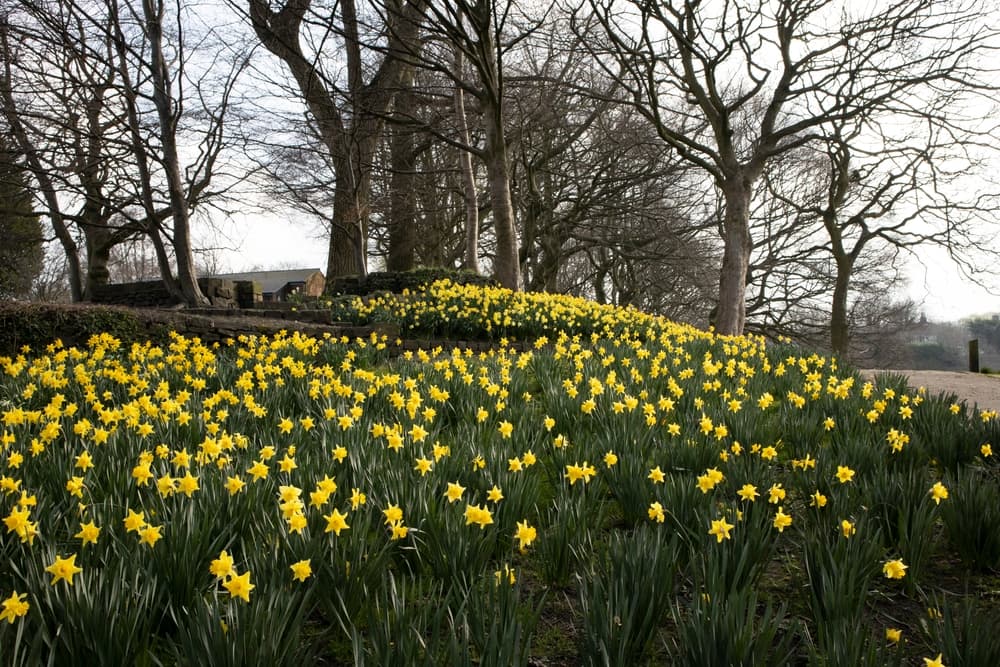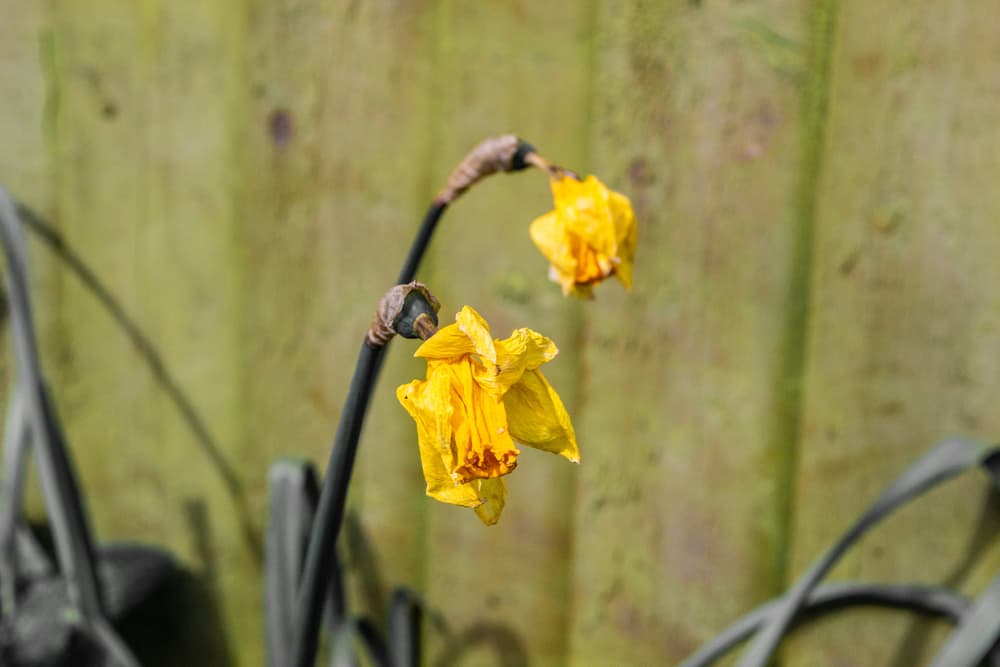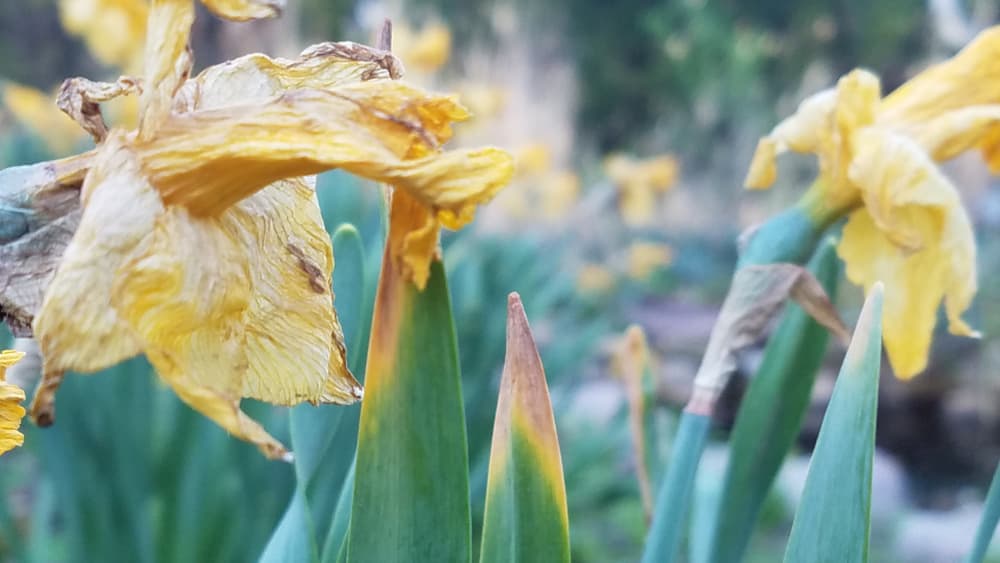BULBS > DAFFODILS
Reviewed By COLIN SKELLY

Colin is a Horticulturist and Horticultural Consultant with experience in a range of practical and managerial roles across heritage, commercial and public horticulture. He holds the Royal Horticultural Society’s Master of Horticulture award and has a particular interest in horticultural ecology and naturalistic planting for habitat and climate resilience.
Contributions From ANNE WRIGHT

Anne is the owner of Dryad Nursery, a Daffodil and Snowdrop specialist and nursery based in North Yorkshire here in the UK.

Janet is an accredited judge and judge instructor for national and local shows; she has also received the 2022 American Daffodil Society Silver Medal in recognition of her service.
IN THIS GUIDE
DAFFODIL GUIDES
Daffodils are among the most popular of perennial flowers, radiating, as they do, a merry innocence with their nodding friendliness, and offering – dare we say – “such a jocund company”!1Wordsworth, W. (n.d.). daffodils. Retrieved March 14, 2023, from https://www.sccs.swarthmore.edu/users/01/jillyb/daffodils.htm
Narcissus, commonly called ‘daffodil’ in the United Kingdom and Northern USA, is a genus of long-lived perennial spring bulbs.
In this guide, we’ve teamed up with:
- Anne Wright, Owner of Dryad Nursery.
- Janet Hickman, President of The American Daffodil Society.
“Daffodils brighten up the spring,” says Janet, when asked why she is so passionate about growing these lovely flowering bulbs.
“They are easy to grow, require no special pesticides, chemicals, or pruning techniques and are not generally troubled by deer or other garden invaders.”
Daffodil flowers typically comprise of a conspicuous corona surrounded by six tepals.
Flattened strap-like leaves are attached to the base of the main stem.
Overview
| Botanical Name | Narcissus |
| Common Name(s) | Daffodil |
| Plant Type | Bulb |
| Native Area | Southern Europe and North Africa |
| Hardiness Rating | H6 |
| Foliage | Herbaceous, linear leaves |
| Flowers | Recognisable flowers with trumpet or cup-like centres |
| When To Sow | September, October |
| Flowering Months | February, March, April, May |
| When To Prune | July |
Sunlight
Preferred
Full Sun / Partial Shade
Exposure
Exposed or Sheltered
Size
Height
0.1 – 0.5M
Spread
0 – 0.1M
Bloom Time
March – June
Soil
Preferred
Most Soil Types
Moisture
Moist but well drained
pH
Any
The botanical origins of Narcissi lie in the Iberian Peninsula some 25 to 20 million years ago.2New data on daffodils of the Narcissus nevadensis complex (Amaryllidaceae) in SE Spain: (n.d.). Phytotaxa. Retrieved March 14, 2023, from https://www.biotaxa.org/Phytotaxa/article/view/phytotaxa.371.2.8
Although the landmasses surrounding the Mediterranean Sea are prime daffodil country where the greatest diversity is found, the flower occurs naturally in most of Europe, in Northern Africa, and eastwards through to Iran.

Its habitats are many and varied as daffodils grow on rocky escarpments as well as marshland, in Switzerland’s mountainous pastures and in French grasslands and woods.
Although Narcissus plants were much-liked and cultivated even in Ancient Times, their popularity took off in the 16th Century when they began to be cultivated.3Rowallane Garden. (n.d.). National Trust. Retrieved March 14, 2023, from https://www.nationaltrust.org.uk/visit/northern-ireland/rowallane-garden

Then along came William Wordsworth and catapulted this hitherto humble wildflower into stratospheric fame in the early 1800s.4I Wandered Lonely as a Cloud by William Wordsworth. (n.d.). Poetry Foundation. Retrieved March 14, 2023, from https://www.poetryfoundation.org/poems/45521/i-wandered-lonely-as-a-cloud
Since then, varieties and cultivars of this wildflower have multiplied even more rapidly.
The UK is the world’s leading producer of daffodil bulbs and is also a top-three exporter.5Why don’t we grow daffodils in Wales? (2013, April 19). North Wales Live. Retrieved March 14, 2023, from https://www.dailypost.co.uk/business/business-news/dont-grow-daffodils-wales-2914445
Planting Daffodils

Daffodil are among the easiest flowers to plant and grow, as Anne explains: “They don’t take up much space and add pleasing colours to a perennial garden.”
Bulbs are usually planted from September and October, latest by November.
Planted thus in autumn, they put out roots through the winter with their flowers being the voiceless heralds of spring.
The bulbs should be planted with the nose up, 8-15cm deep depending on the size of the bulb and kept well-watered.
“They like plenty of water while they are actively growing but dry conditions while dormant,” says Janet.
Daffodil Care
In view of the vast variety of daffodils and the geographical regions and terrains that they inhabit, a one-size-fits-all approach to feeding and care is not possible.
Soil & Fertilisation
That stated, as a general rule daffodils are perfectly content in any old soil but they thrive especially well in rich, loamy soils.
Good drainage is necessary for this bulbous plant – and Anne Wright even considers it the most important factor in their care.

Daffodils’ optimal soil pH range is 6.5-7.0 but they are not fussy and make do in more acidic or alkaline soils.
Experts from both Dryad Nursery and the American Daffodil Society agree that fertilising your daffodils can help improve the plant’s general health.
They do very well without fertiliser but if your soil is poor or the plants are not healthy, sprinkle some bone meal, special bulb fertiliser, or a feed like Growmore when the plants are flowering.
Janet recommends choosing a feed that is low in nitrogen for your daffodils.
Preferred Aspect
Daffodils have a preference for sun but also do quite well in partial shade.
“If planting in partial shade, the site may become shadier as time passes and surrounding trees and shrubs develop,” shares Colin Skelly, a Horticultural Consultant.
“This may cause the daffodils to come up ‘blind’ (not flower).
“Cut back to allow light to reach the foliage to allow more energy to be stored in the bulb – this should restore flowering.”

Daffodils should be watered regularly in spring and autumn.
They take the summer ‘off’ – going dormant and should not be watered during this season.
When Do Daffodils Bloom?
Daffodils begin to bloom as early as February.
Most species and cultivars bloom in March and April, with some putting out flowers in early May.

May is the month that Montreaux, renowned for its jazz festivals, holds its annual Narcissi Festival.6The narcissus forecasting. (n.d.). Narcisses. Retrieved March 14, 2023, from https://www.narcisses.com/
Over and above daffodils’ natural blooming cycle, as daffodil flowers are in demand in December, bulbs are manipulated by keeping them at different temperatures for varying periods of time before they are planted in a greenhouse in November for the plant to bloom in mid-December.
This is called ‘forcing’.
Pruning
“Since it is relatively uncommon for modern hybrid daffodils to set seeds without a hybridizer’s help, deadheading is not an essential chore,” says Janet.
“If deadheading for appearance’s sake, leave the stem while it is green to continue nourishing the bulb.”

After the flowering season is over in May, the leaves develop reserves of energy for the bulbs.
Let them be until they are wilted and dead, which will usually happen about eight weeks after flowering season, and then cut them back.
“Don’t accidentally dig them up when they’re dormant!” warns Anne.
“Once planted, I leave them in the ground and don’t lift and divide them for the best results.”
Common Problems
Daffodils are typically healthy pest- and disease-resistant plants.
However, if and when they are afflicted by something, the causes can be many and widespread.

Pests include the narcissus bulb fly, their larvae, nematodes, slugs and snails.
They can also be infected by viruses and fungi, basal rot or other types of rot.
Narcissus Bulb Fly
The narcissus bulb fly, easily mistaken for a smallish bumble bee, itself does no harm.
The problem is that it lays eggs in the soil from which larvae emerge and burrow into the bulb.

They feed upon the bulb from within and destroy it.
You can make your soil larva-resistant by packing it tightly, mulching it, and using insect nets.
Remove and discard infested bulbs to prevent the infestation from spreading.
Nematodes
If your bulbs are infested with nematodes, for severe infestations you will be best off disposing of the infested bulbs and also quarantining the patch of soil where the infestation occurred.
Fungal Issues
“Basal rot caused by the fungus Fusarium oxysporum can destroy or damage bulbs, especially in any ground that stays too wet,” says Janet.

If your bulb has basal rot, you will have to throw it away.
One of the best ways to practice the prevention principle is to buy bulbs from reputable and established growers and sellers, to plant only the biggest bulbs, to plant bulbs that have no wounds, mould, or discolouration, and to ensure that your soil is not waterlogged and is well-drained.
Ensuring good gardening habits is also important to prevent the spread of disease, Janet explains:
“Take care when disinfecting tools and pick daffodils by snapping the stem rather than cutting them, as this can help prevent the spread of viruses that affect the blooms or leaves.”
FAQs
Are Daffodils Native To Britain?
Yes, daffodils are native to Britain.

However, they did not originate in Britain nor is the landmass a centre of diversity.
They were introduced into Britain in Ancient Times and have been cultivated since no later than the 1500s.
The daffodil varieties seen in gardens are usually not Britain’s native species; native species can be seen growing wild in fields, meadows, and along watercourses.7Where To See Wild Daffodils In The UK. (2021, February 22). Woodland Trust. Retrieved March 14, 2023, from https://www.woodlandtrust.org.uk/blog/2021/02/where-to-see-wild-daffodils/
How Should I Store Daffodil Bulbs?
If you are planning to store bulbs dug up from the soil, first trim the roots by snipping off their unattached, free-running parts.
Then sun dry the bulbs for about 12 hours and store them in a dry room for a further 12 hours as it is important that they be free of dampness.

Regardless of whether the bulbs have been dug up or are freshly-bought, store them in a cool, dry, and dark room.
The optimal temperature is between 16-18°C with a margin of, say, three degrees.
Keep them in a mesh bag so that the bulbs are exposed to air.
If you live in a warm climate and do not have a climate-controlled room, store the bulbs in the fridge’s crisper but do not keep any fruit, especially apples, in the same fridge.
Should You Deadhead Daffodils?
As a general rule, yes.
Although daffodils inter-breed and the hybrids could result in unusual and attractive varieties, two considerations are paramount.
It takes four or five years for daffodil seeds to develop into bulbs that produce flowers whereas you can buy bulbs that are ready to flower.

Second, seed development channels nutrients to the seed-pod, leaving the bulb itself with fewer resources and energy for the following season.
As a result, your bulb may bear very few or no flowers.
Do Daffodil Bulbs Multiply In The Ground?
Yes, they produce offsets or ‘daughter’ bulbs, and over time clumps of bulbs are formed.
This is known as cloning.

The daughter bulbs are smaller and are positioned right beside the parent bulb which initially nourishes the ‘daughter’.
As the bulbs multiply, after some years too many bulbs end up occupying a relatively small area of soil.
When this happens the bulbs need to be dug up and separated.
References
- 1Wordsworth, W. (n.d.). daffodils. Retrieved March 14, 2023, from https://www.sccs.swarthmore.edu/users/01/jillyb/daffodils.htm
- 2New data on daffodils of the Narcissus nevadensis complex (Amaryllidaceae) in SE Spain: (n.d.). Phytotaxa. Retrieved March 14, 2023, from https://www.biotaxa.org/Phytotaxa/article/view/phytotaxa.371.2.8
- 3Rowallane Garden. (n.d.). National Trust. Retrieved March 14, 2023, from https://www.nationaltrust.org.uk/visit/northern-ireland/rowallane-garden
- 4I Wandered Lonely as a Cloud by William Wordsworth. (n.d.). Poetry Foundation. Retrieved March 14, 2023, from https://www.poetryfoundation.org/poems/45521/i-wandered-lonely-as-a-cloud
- 5Why don’t we grow daffodils in Wales? (2013, April 19). North Wales Live. Retrieved March 14, 2023, from https://www.dailypost.co.uk/business/business-news/dont-grow-daffodils-wales-2914445
- 6The narcissus forecasting. (n.d.). Narcisses. Retrieved March 14, 2023, from https://www.narcisses.com/
- 7Where To See Wild Daffodils In The UK. (2021, February 22). Woodland Trust. Retrieved March 14, 2023, from https://www.woodlandtrust.org.uk/blog/2021/02/where-to-see-wild-daffodils/


